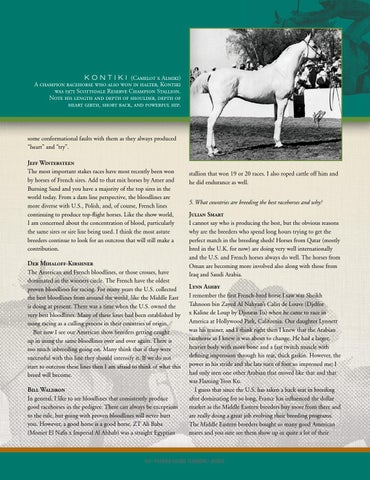K O N T I K I (Camelot x Almiki) A champion racehorse who also won in halter, Kontiki was 1971 Scottsdale Reserve Champion Stallion. Note his length and depth of shoulder, depth of heart girth, short back, and powerful hip.
some conformational faults with them as they always produced “heart” and “try”. Jeff Wintersteen The most important stakes races have most recently been won by horses of French sires. Add to that mix horses by Amer and Burning Sand and you have a majority of the top sires in the world today. From a dam line perspective, the bloodlines are more diverse with U.S., Polish, and, of course, French lines continuing to produce top-flight horses. Like the show world, I am concerned about the concentration of blood, particularly the same sires or sire line being used. I think the most astute breeders continue to look for an outcross that will still make a contribution. Deb Mihaloff-Kirshner The American and French bloodlines, or those crosses, have dominated in the winners circle. The French have the oldest proven bloodlines for racing. For many years the U.S. collected the best bloodlines from around the world, like the Middle East is doing at present. There was a time when the U.S. owned the very best bloodlines. Many of these lines had been established by using racing as a culling process in their countries of origin. But now I see our American show breeders getting caught up in using the same bloodlines over and over again. There is too much inbreeding going on. Many think that if they were successful with this line they should intensify it. If we do not start to outcross these lines then I am afraid to think of what this breed will become. Bill Waldron In general, I like to see bloodlines that consistently produce good racehorses in the pedigree. There can always be exceptions to the rule, but going with proven bloodlines will never hurt you. However, a good horse is a good horse. ZT Ali Baba (Moniet El Nafis x Imperial Al Ahbab) was a straight Egyptian
stallion that won 19 or 20 races. I also roped cattle off him and he did endurance as well. 5. What countries are breeding the best racehorses and why? Julian Smart I cannot say who is producing the best, but the obvious reasons why are the breeders who spend long hours trying to get the perfect match in the breeding sheds! Horses from Qatar (mostly bred in the U.K. for now) are doing very well internationally and the U.S. and French horses always do well. The horses from Oman are becoming more involved also along with those from Iraq and Saudi Arabia. Lynn Ashby I remember the first French-bred horse I saw was Sheikh Tahnoon bin Zayed Al Nahyan’s Calin de Louve (Djelfor x Kaline de Loup by Djouras Tu) when he came to race in America at Hollywood Park, California. Our daughter Lynnett was his trainer, and I think right then I knew that the Arabian racehorse as I knew it was about to change. He had a larger, heavier body with more bone and a fast twitch muscle with defining impression through his rear, thick gaskin. However, the power in his stride and the late turn of foot so impressed me; I had only seen one other Arabian that moved like that and that was Flaming Tron Ku. I guess that since the U.S. has taken a back seat in breeding after dominating for so long, France has influenced the dollar market as the Middle Eastern breeders buy more from there and are really doing a great job evolving their breeding programs. The Middle Eastern breeders bought so many good American mares and you sure see them show up in quite a lot of their
63 ▪ ARABIAN RACING YEARBOOK ▪ WORLD
